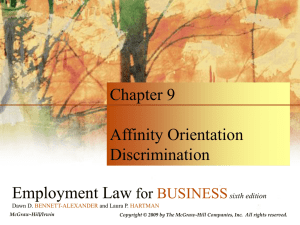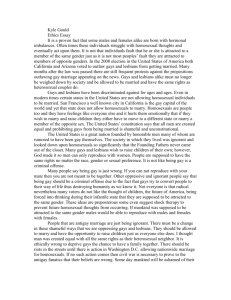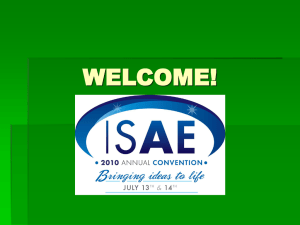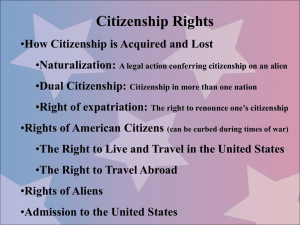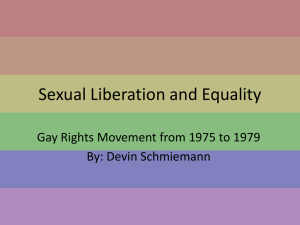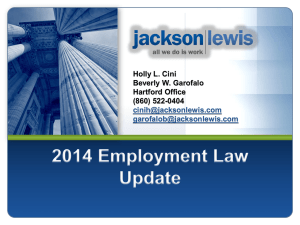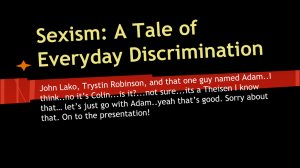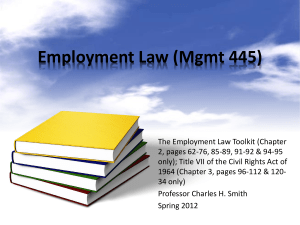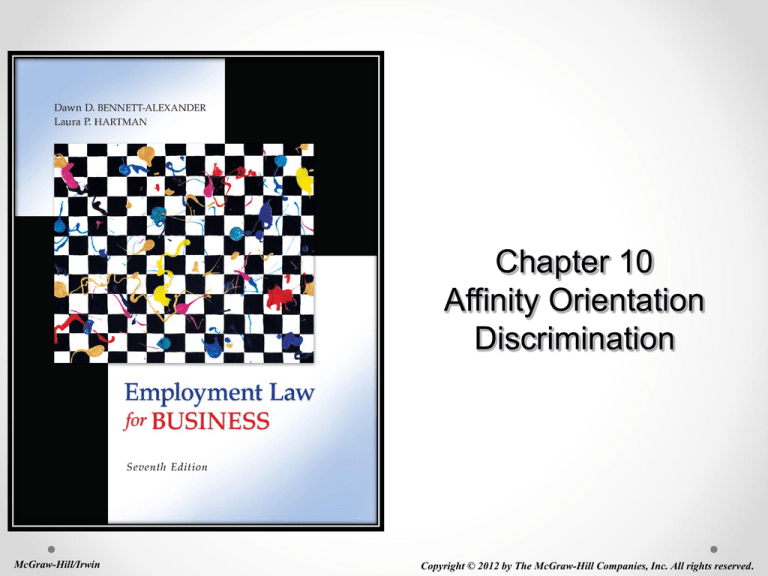
Chapter 10
Affinity Orientation
Discrimination
McGraw-Hill/Irwin
Copyright © 2012 by The McGraw-Hill Companies, Inc. All rights reserved.
Learning Objectives
Relate the history of the modern gay rights
movement
Name the states that include gays and lesbians
in their antidiscrimination laws as well as Title
VII’s position
Give the pros and cons of employers being
inclusive of gay and lesbian employees
10-2
Learning Objectives
Discuss how some courts have circumvented
the exclusion of gays and lesbians from Title VII
coverage
Identify whether same-gender sexual
harassment is covered by Title VII
Discuss the workplace issues involving
transgenders
10-3
Learning Objectives
Identify some of the employment benefits issues
for gays and lesbians
List some ways that employers can address gay
and lesbian issues in the workplace
10-4
Introduction
Affinity orientation: Whom one is attracted to
for personal and intimate relationships
Affinity orientation pushes a lot of buttons in
society and the workplace
It is an issue all across the world
Vast implications for people’s everyday lives
10-5
Introduction
Personal beliefs must not affect workplace
behavior
May lead to employer liability
10-6
States that Prohibit Discrimination on the Basis of
Affinity Orientation or Gender Identity
California
Colorado
Connecticut
Delaware
Hawaii
Illinois
Iowa
Maine
Maryland
Massachusetts
Minnesota
New
Hampshire
New
New
New
Jersey
Mexico
York
Nevada
Oregon
Rhode Island
Vermont
Washington
Wisconsin
Washington,
D.C.
10-7
Historical Issues
The impact of AIDS in society and in the workplace
The military’s “don’t ask, don’t tell” policy
The 1993 March on Washington for Lesbians, Gays, and Bisexuals
President Bill Clinton voices support for gays (1992)
Clinton’s support for the Employment Nondiscrimination Act [ENDA]
Clinton’s appointment of over 150 gays and lesbians in his administration
Colorado’s attempted constitutional ban on protection for gays and lesbians
10-8
Out of the Closet
The resistance at Stonewall in 1969
Gay Pride Month
Employment Non-discrimination Act (ENDA)
Not yet passed by Congress
Extends Title VII’s reach to include discrimination on
the basis of affinity orientation
10-9
Out of the Closet
Company support of gay and lesbian events
Gay Pride
Domestic partnership benefits
National Coming Out Day
Base workplace decisions solely on an
employee’s ability to perform the job
10-10
Out of the Closet
Affinity orientation is not covered under Title VII
Discrimination is prohibited under
Local ordinances or executive orders
State laws
Every state in the union has some form of job
discrimination protection for gays and lesbians
Gender identity statutes: Laws providing
protection for transgenders
10-11
Out of the Closet
Other bases for discrimination claims
First, Fifth, or Fourteenth Amendments of the U.S.
Constitution
Constitutional right to privacy
Civil tort actions
Gender stereotyping – liability for gender
discrimination
10-12
Affinity Orientation as a Basis for
Adverse Employment Decisions
Employer concerns if the employee:
Is gay or lesbian
Has primary relationships with those of the same
gender
Exhibits inappropriate workplace behavior
Wears clothing, jewelry, or make-up in violation of
workplace grooming codes
Is in the presurgery adjustment stages of GR surgery
Undergoes gender reassignment surgery
10-13
Affinity Orientation as a Basis for
Adverse Employment Decisions
Employers should
Make a distinction between status or orientation and
inappropriate activity
Actions should not be singled out based solely on the
actor’s orientation
10-14
Affinity Orientation as a Basis for
Adverse Employment Decisions
Employee may fit into more than one category
Liability will ensue if one or more of the categories are
protected under Title VII
Gender-based stereotypes
10-15
Same-Gender Sexual Harassment
U.S. Supreme Court
A cause of action for sexual harassment even if both
parties are of the same gender
Basis for harassment must not be the affinity
orientation of the harassee
10-16
Gender Identity Discrimination
Gender dysphoria
Gender identity not a protected category under
Title VII
Protection under some state and local laws
Human Rights Campaign
The number of Fortune 500 companies with gender
identity protection in their policies has quadrupled just
since 2003
10-17
Workplace Issues for Gays and
Lesbians
Nondiscrimination policies
Bereavement leave for domestic partners
Vacation leave transfer
Benefits for domestic partners
10-18
Domestic Partner Law Debate
Domestic partner law protects personal wishes
such as
The right to have your partner visit if you’re
hospitalized
The right to have your partner act as guardian if
you’re incapacitated
The right to leave your money and property to who
you wish in your will with no court battles from
relatives
10-19
Domestic Partner Law Debate
Growth of benefits
Opposing view
Law will legitimize cohabitation
Domestic partnership will weaken the institution of
marriage
Man/woman relationship is best for society
10-20
Employment Benefits
Benefits that other employees take for granted
are major hurdles for gays and lesbians
Five states allow same-gender marriages
Registration of unmarried couples as domestic
partners
Living together for a specified length of time
Given mutual aid and support
10-21
Employment Benefits
Nearly half of the Fortune 500 companies offer
domestic partner benefits
90 percent cover a domestic partner’s dependents or
children
60 percent extend adoption assistance to domestic
partners
72 percent also allow employees to take extended
family leave to care for a domestic partner or their
dependents
10-22
Employment Benefits
Companies use benefits as a marketing tool to
attract and retain gay and lesbian employees
Single-gender couples with children
10-23
Management Considerations
Employers who prefer the benefits of a diverse
workplace
Deal with affinity orientation issues in a less restrictive
manner
Not have policies that have a hard-and-fast rule of “no
transgenders, gays, or lesbians allowed”
10-24
Management Considerations
Actions of gays or lesbians should be dealt with
as legitimate workplace issues
Affinity orientation or gender identity is irrelevant to
the activity
Gender identity and affinity orientation policies
should come from the top
10-25
Management Considerations
Employers who do not wish to have
antidiscrimination based on affinity orientation
and gender identity
Liability depends on the jurisdiction in which the
employer is located
Employer’s personal choice
May wish to take an adverse workplace decision to
court to maintain maximum control over areas not as
heavily regulated as the other protected categories
10-26
Management Considerations
Some employers take a middle-ground position
No policies to support or prohibit discrimination
Deal with issues on a case-by-case basis
Laws are changing every day
Employers should consider possible
repercussions other than liability under Title VII
10-27
Management Tips
Hire using only relevant, work-related criteria
Keep inquiries about applicants’ personal lives
minimal and relevant
Have a policy ensuring all employees respect in
the workplace
Policy should protect everyone from unsolicited
negative statements about immutable and other
characteristics
10-28
Management Tips
Take prompt action whenever there are
complaints or violations of the policy
Proactively decide what position to take on
affinity orientation-related issues
Be aware of the potential impact on gays and
lesbians of workplace policies
Ensure that policies inclusive of gays and
lesbians, ensure are fair and handled evenly
10-29

